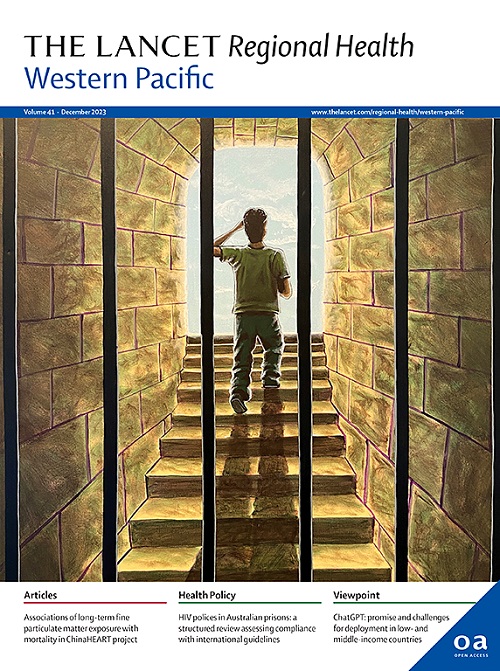Non-cancer risks among female breast cancer survivors: a matched cohort study in Japan
IF 7.6
1区 医学
Q1 HEALTH CARE SCIENCES & SERVICES
引用次数: 0
Abstract
Background
The number of breast cancer (BC) survivors has increased worldwide, but the landscape of their non-cancer disease risks remains unclear, especially among Asian women.
Methods
In the JMDC claims database, which covers company employees and their family members in Japan, women aged 18–74 years with and without an incident BC were matched in a 1:4 ratio for age and entry timing to the database between January 2005 and December 2019. The risks for six cardiovascular diseases (myocardial infarction, heart failure, atrial fibrillation/flutter, ischaemic stroke, intracranial haemorrhage, and pulmonary embolism) and six non-cardiovascular diseases (major osteoporotic fractures, other fractures, gastrointestinal bleeding, urinary tract infection, infectious pneumonia, and anxiety/depression) were compared between the groups.
Findings
Comparing 24,017 BC survivors and 96,068 matched women (mean age, 50.5 years, standard deviation, 8.7 years), the incidence rates of heart failure, atrial fibrillation/flutter, and all non-cardiovascular diseases were higher in the BC survivor group. The highest adjusted hazard ratio (HR) was noted for heart failure (3.99 [95% confidence interval 2.58–6.16]), followed by gastrointestinal bleeding (3.55 [3.10–4.06]), and anxiety/depression (3.06 [2.86–3.28]). The HRs in the first year were larger than those for 1–10 years for most outcomes, whereas the HRs for fracture outcomes were larger for 1–10 years.
Interpretation
BC survivors in Japan showed an increased risk of many non-cancer diseases compared to women without BC. Most risks increased more steeply during the first year following diagnosis, whereas the risk of fractures increased later.
Funding
Competitive research funding from Pfizer Health Research Foundation in Japan.
女性乳腺癌幸存者的非癌症风险:日本的一项匹配队列研究
乳腺癌(BC)幸存者的数量在全球范围内有所增加,但其非癌症疾病风险的情况仍不清楚,特别是在亚洲女性中。方法在JMDC索赔数据库中,该数据库涵盖了日本的公司员工及其家庭成员,在2005年1月至2019年12月期间,年龄在18-74岁之间,患有和未发生BC事件的女性以1:4的年龄和进入时间匹配数据库。比较两组患者发生6种心血管疾病(心肌梗死、心力衰竭、心房颤动/颤振、缺血性卒中、颅内出血和肺栓塞)和6种非心血管疾病(骨质疏松性骨折、其他骨折、胃肠道出血、尿路感染、感染性肺炎和焦虑/抑郁)的风险。研究结果:比较24,017名BC幸存者和96,068名匹配的女性(平均年龄50.5岁,标准差8.7岁),BC幸存者组的心力衰竭、心房颤动/扑颤和所有非心血管疾病的发病率更高。调整后的危险比(HR)最高的是心力衰竭(3.99[95%可信区间2.58-6.16]),其次是胃肠道出血(3.55[3.10-4.06])和焦虑/抑郁(3.06[2.86-3.28])。大多数结果第一年的hr大于1-10年的hr,而骨折结果的hr大于1-10年的hr。解释:与没有BC的女性相比,日本的BC幸存者显示出许多非癌症疾病的风险增加。大多数风险在诊断后的第一年急剧增加,而骨折的风险随后增加。来自日本辉瑞健康研究基金会的竞争性研究资金。
本文章由计算机程序翻译,如有差异,请以英文原文为准。
求助全文
约1分钟内获得全文
求助全文
来源期刊

The Lancet Regional Health: Western Pacific
Medicine-Pediatrics, Perinatology and Child Health
CiteScore
8.80
自引率
2.80%
发文量
305
审稿时长
11 weeks
期刊介绍:
The Lancet Regional Health – Western Pacific, a gold open access journal, is an integral part of The Lancet's global initiative advocating for healthcare quality and access worldwide. It aims to advance clinical practice and health policy in the Western Pacific region, contributing to enhanced health outcomes. The journal publishes high-quality original research shedding light on clinical practice and health policy in the region. It also includes reviews, commentaries, and opinion pieces covering diverse regional health topics, such as infectious diseases, non-communicable diseases, child and adolescent health, maternal and reproductive health, aging health, mental health, the health workforce and systems, and health policy.
 求助内容:
求助内容: 应助结果提醒方式:
应助结果提醒方式:


